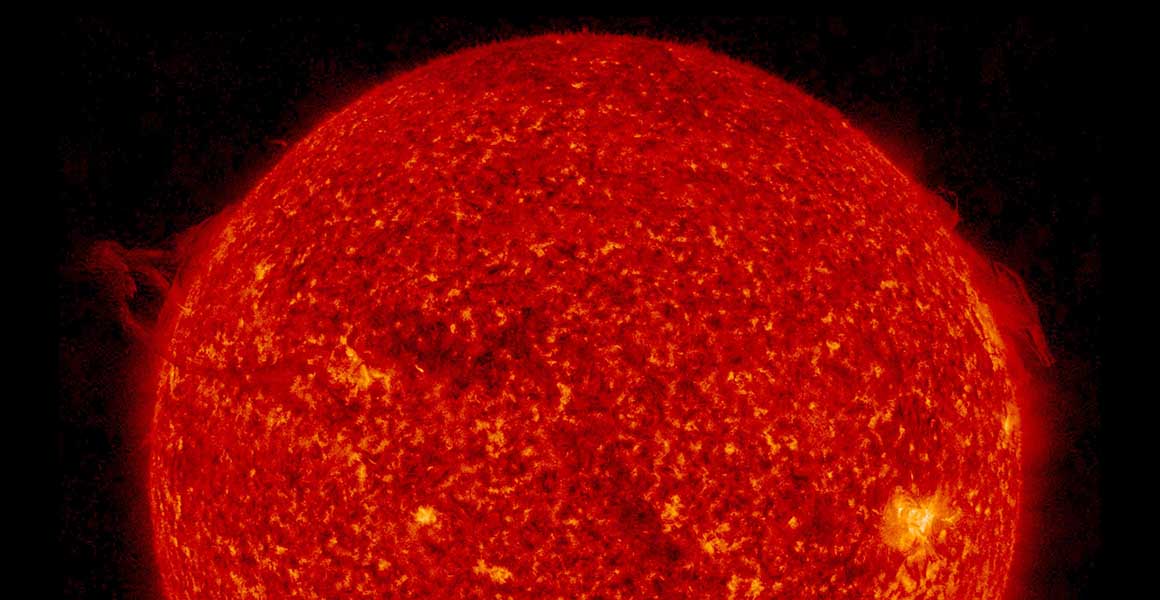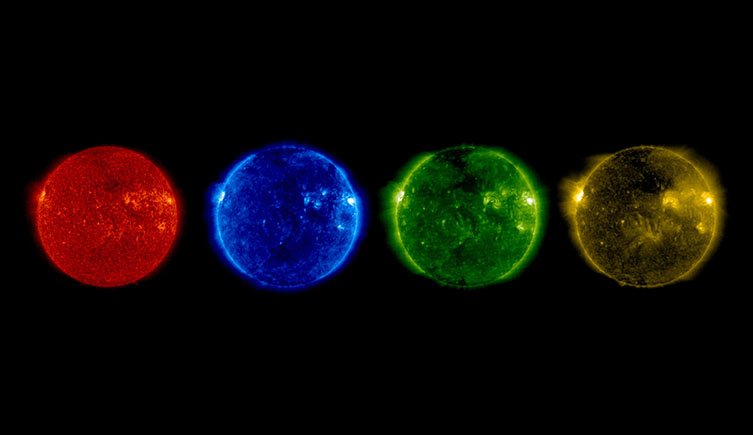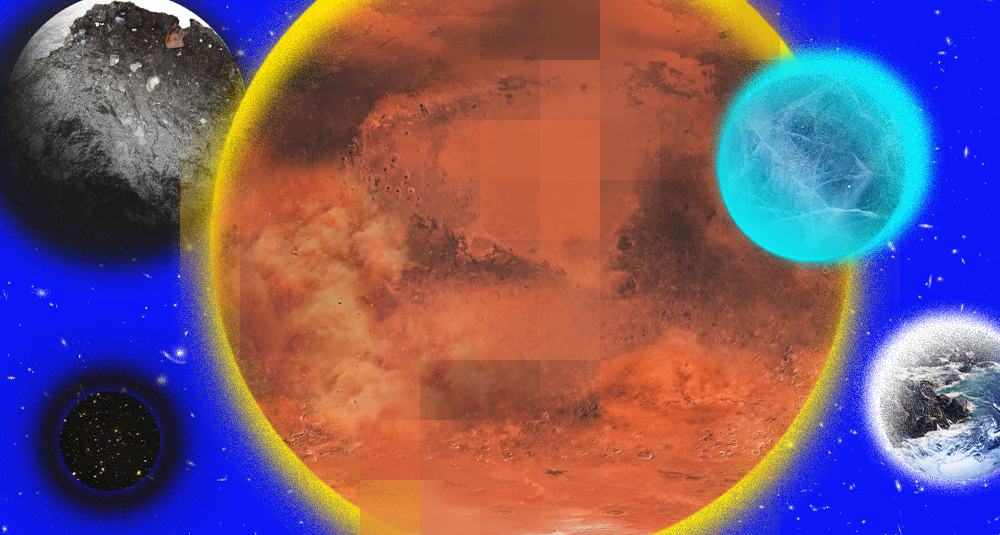The centre of the solar system around which all the planets, moons, comets and asteroids orbit, the Sun's heat and light are essential for life.
Explore facts about the biggest and hottest object in the solar system.

The Sun is a huge ball of gas and plasma, sitting at the centre of the solar system © NASA/GSFC/Solar Dynamics Observatory
The centre of the solar system around which all the planets, moons, comets and asteroids orbit, the Sun's heat and light are essential for life.
Explore facts about the biggest and hottest object in the solar system.

The Sun is the biggest object in our solar system, with a distance of 695,508 from to surface. It contains 99.86% of the mass of the entire solar system and could contain roughly 1.3 million Earths.
The Sun is an average-sized star. Some stars are just a tenth of its size, while others are more than 700 times bigger. Due to its huge mass and strong gravity, the Sun is a sphere.
The core is the hottest part of the Sun, at 15 million degrees Celsius. This is hot enough to sustain thermonuclear when hydrogen atoms are fused together to form larger helium atoms. This releases an extraordinary amount of energy which in turn is released as heat and light.
The energy produced at the core takes up to a million years to reach the outer layer known as the convective zone. At this the temperature drops to around two million degrees Celsius. By the time it gets to the surface the temperature is down to a much cooler 5,973°C - but it's still hot enough to boil diamonds.
In the Sun's atmosphere, known as the corona, the temperature begins to rise again to roughly two million degrees Celsius. As from the core of the Sun grows wider, the temperature would be expected to drop. This dramatic increase in temperature in the atmosphere is one of the star's biggest mysteries.

The Sun at different ultraviolet wavelengths, (l-r) the bright spots are 60 000–80 000ºC, 1 million, 1.5 million and 2 million degrees © SOHO/ESA/NASA
The Sun is a ball of gas and plasma - around 91% of it is hydrogen gas. Under intense heat and gravitational force this is fused into helium during nuclear fusion.
When the plasma is heated to the temperatures seen on the Sun, it contains so much energy that the charged particles can escape the star's gravity and blow out into space. This is called solar wind - under certain conditions, when it hits Earth's atmosphere it can cause auroras, such as the Northern Lights.
In addition to hydrogen and helium, scientists have detected at least 65 other elements in the Sun. The most abundant of these include oxygen, carbon, nitrogen, silicon, magnesium, neon, iron, and sulphur.
Yes. Even though the Sun is not solid like Earth, it still has a rotation as the plasma swirls around its surface. On average, it takes 27 Earth days for the Sun to rotate once on its axis, but different parts move at different speeds. The equatorial regions take just 24 days to rotate and the polar regions more than 30.
Sunspots are cooler parts of the Sun's surface, and occur in the photosphere. The temporary splodges across the surface appear darker to us than the warmer plasma surrounding it.
These cooler spots can be up to 50,000 kilometres across. They are thought to be caused by interactions with particularly strong regions of the underlying magnetic field, which slightly reduce the radiation coming up from the core, cooling the surface.

Sunspots are cooler regions of the Sun's surface© SOHO/ESA/NASA
Solar flares are the largest explosive events in the entire solar system. They occur when the magnetic fields associated with the sunspots convert energy into heat and accelerating particles, ejecting it into space.
They are by a burst of photons - or light - at almost every wavelength. Scientists usually measure the ultraviolet rays, X-rays gamma-rays coming from the solar flares. These typically show up as bright flashes on the surface of the and can last from just a couple of minutes to a few hours.
The Sun is currently a yellow dwarf. Like all stars, it began as a contracting nebula - effectively a cloud of dust and gas.
As each particle has its own tiny gravitational pull, the dust and gas began to coalesce into a protostar. As this mass is pulled together and collapses in on itself it generates heat. If it becomes big enough it will eventually get sufficiently hot to fuse hydrogen into helium. This was how the Sun formed.
The celestial object then enters its main sequence stage, during which the outward pressure of nuclear fusion is balanced by the inward pressure of the stars own gravity. The Sun is currently in this stable phase.

A solar flare as seen in high energy X-rays © NASA/JPL-Caltech/GSFC
It won't. When all of the hydrogen in its core is burned up, it exits the main sequence stage.
As a relatively small star, the outer layers of the Sun will collapse in on themselves, creating temperatures hot enough to fuse helium into carbon. At this the pressure will cause the star to rapidly expand outward to form a red giant.
For the Sun, this is expected to occur in about five billion years. It is likely to engulf Mercury and Venus - and potentially even the Earth.
It will eventually shrink to become a planetary nebula with a white dwarf at its core.
There are an estimated 100 billion galaxies in the known universe. The Sun and its eight planets, including Earth, reside in one known as the Milky Way. Our galaxy is around one quintillion or 100,000 light years.
The Sun is in a spiral arm of the Milky Way called the Orion Spur. This branches off from the galaxy's Sagittarius arm. The Sun and our solar system are orbiting around the of the Milky Way at a speed of 720,000 per hour. It takes 230 million years to make one complete orbit.

A total solar eclipse seen from Casper, Wyoming (US) © ESA/MP Ayucar, CC BY-SA 3.0 IGO
Sometimes the Moon comes between the Sun and Earth. If all three are aligned, the Moon can block the Sun entirely, casting a shadow on Earth and causing a solar eclipse. This is because even though the Sun is 400 times larger than the Moon, the Moon is 400 times closer to Earth.
Solar eclipses occur roughly every six months, but total solar eclipses, in which the Sun is completely obscured by the Moon, are much rarer. They tend to occur around every two years, although often in remote areas of the Earth. These total eclipses can last for as little as a few seconds, but never longer than seven minutes.
Due to its extreme temperatures studying the Sun with spacecrafts is incredibly difficult. We have to rely on observations using telescopes and cameras on Earth satellites.
However, in 2020 the European Space Agency and NASA launched the Solar Orbiter, which will enter an elliptical orbit of the Sun allowing unprecedented observations.
After taking three and a half years to reach the Sun, it will begin a seven year mission to study the stars solar wind, magnetic fields, and plasma. It will orbit as close as 42 million kilometres from the Sun's surface, closer even than Mercury.

Discover more about the natural world beyond Earth's stratosphere.

Find out in our latest exhibition! Snap a selfie with a piece of Mars, touch a fragment of the Moon and lay your hands on a meteorite older than our planet.
Open now
Don't miss a thing
Receive email updates about our news, science, exhibitions, events, products, services and fundraising activities. We may occasionally include third-party content from our corporate partners and other museums. We will not share your personal details with these third parties. You must be over the age of 13. Privacy notice.
Follow us on social media